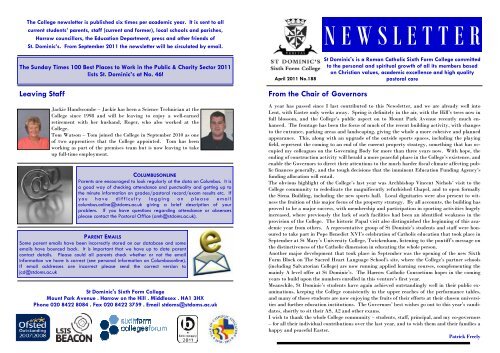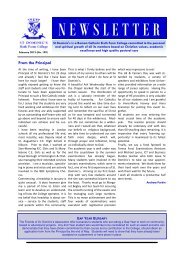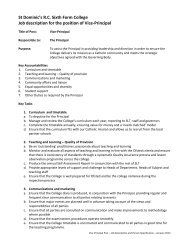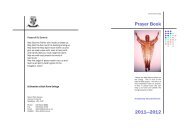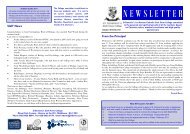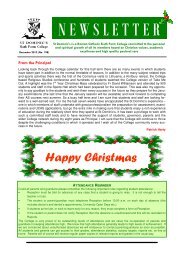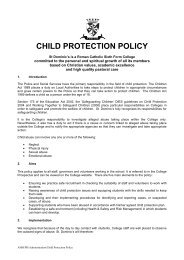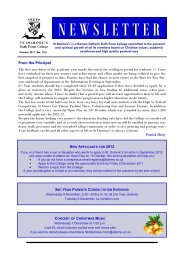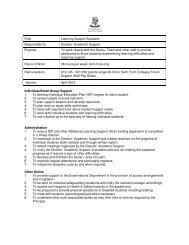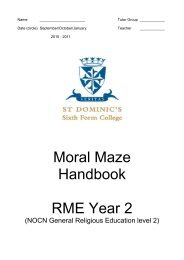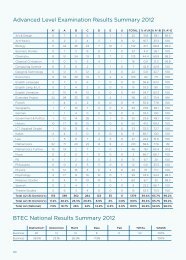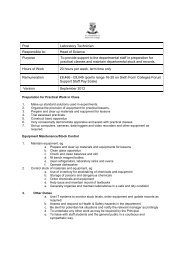April 2011 - St Dominics | Sixth Form College
April 2011 - St Dominics | Sixth Form College
April 2011 - St Dominics | Sixth Form College
- No tags were found...
You also want an ePaper? Increase the reach of your titles
YUMPU automatically turns print PDFs into web optimized ePapers that Google loves.
The <strong>College</strong> newsletter is published six times per academic year. It is sent to allcurrent students’ parents, staff (current and former), local schools and parishes,Harrow councillors, the Education Department, press and other friends of<strong>St</strong>. Dominic’s. From September <strong>2011</strong> the newsletter will be circulated by email.The Sunday Times 100 Best Places to Work in the Public & Charity Sector <strong>2011</strong>lists <strong>St</strong>. Dominic’s at No. 46!<strong>April</strong> <strong>2011</strong> No.188N E W S L E T T E R<strong>St</strong> Dominic's is a Roman Catholic <strong>Sixth</strong> <strong>Form</strong> <strong>College</strong> committedto the personal and spiritual growth of all its members basedon Christian values, academic excellence and high qualitypastoral careLeaving <strong>St</strong>affJackie Handscombe – Jackie has been a Science Technician at the<strong>College</strong> since 1998 and will be leaving to enjoy a well-earnedretirement with her husband, Roger, who also worked at the<strong>College</strong>.Tom Watson – Tom joined the <strong>College</strong> in September 2010 as oneof two apprentices that the <strong>College</strong> appointed. Tom has beenworking as part of the premises team but is now leaving to takeup full-time employment.COLUMBUSONLINEParents are encouraged to look regularly at the data on Columbus. It isa good way of checking attendance and punctuality and getting up tothe minute information on grades/pastoral record/exam results etc. Ify o u h a v e d i f f i c u l t y l o g g i n g o n p l e a s e e m a i lcolumbus.online@stdoms.ac.uk giving a brief description of yourproblem. If you have questions regarding attendance or absencesplease contact the Pastoral Office (amh@stdoms.ac.uk).PARENT EMAILSSome parent emails have been incorrectly stored on our database and someemails have bounced back. It is important that we have up to date parentcontact details. Please could all parents check whether or not the emailinformation we have is correct (see personal information on Columbusonline).If email addresses are incorrect please send the correct version tojcd@stdoms.ac.uk<strong>St</strong> Dominic's <strong>Sixth</strong> <strong>Form</strong> <strong>College</strong>Mount Park Avenue . Harrow on the Hill . Middlesex . HA1 3HXPhone 020 8422 8084 . Fax 020 8422 3759 . Email stdoms@stdoms.ac.ukFrom the Chair of GovernorsA year has passed since I last contributed to this Newsletter, and we are already well intoLent, with Easter only weeks away. Spring is definitely in the air, with the Hill’s trees now infull blossom, and the <strong>College</strong>’s public aspect on to Mount Park Avenue recently much enhanced.The frontage has been the focus of much of the recent building activity, with changesto the entrance, parking areas and landscaping, giving the whole a more cohesive and plannedappearance. This, along with an upgrade of the outside sports spaces, including the playingfield, represent the coming to an end of the current property strategy, something that has occupiedmy colleagues on the Governing Body for more than three years now. With hope, theending of construction activity will herald a more peaceful phase in the <strong>College</strong>’s existence, andenable the Governors to direct their attentions to the much harder fiscal climate affecting publicfinances generally, and the tough decisions that the imminent Education Funding Agency’sfunding allocation will entail.The obvious highlight of the <strong>College</strong>’s last year was Archbishop Vincent Nichols’ visit to the<strong>College</strong> community to rededicate the magnificently refurbished Chapel, and to open formallythe Siena Building, including the new sports hall. Local dignitaries were also present to witnessthe fruition of this major focus of the property strategy. By all accounts, the building hasproved to be a major success, with membership and participation in sporting activities hugelyincreased, where previously the lack of such facilities had been an identified weakness in theprovision of the <strong>College</strong>. The historic Papal visit also distinguished the beginning of this academicyear from others. A representative group of <strong>St</strong> Dominic’s students and staff were honouredto take part in Pope Benedict XVI’s celebration of Catholic education that took place inSeptember at <strong>St</strong> Mary’s University <strong>College</strong>, Twickenham, listening to the pontiff’s message onthe distinctiveness of the Catholic dimension in educating the whole person.Another major development that took place in September was the opening of the new <strong>Sixth</strong><strong>Form</strong> Block on The Sacred Heart Language School’s site, where the <strong>College</strong>’s partner schools(including Salvatorian <strong>College</strong>) are now running applied learning courses, complementing themainly A level offer at <strong>St</strong> Dominic’s. The Harrow Catholic Consortium hopes in the comingyears to build upon the numbers enrolled in this venture’s first year.Meanwhile, <strong>St</strong> Dominic’s students have again achieved outstandingly well in their public examinations,keeping the <strong>College</strong> consistently in the upper reaches of the performance tables,and many of those students are now enjoying the fruits of their efforts at their chosen universitiesand further education institutions. The Governors’ best wishes go out to this year’s candidates,shortly to sit their AS, A2 and other exams.I wish to thank the whole <strong>College</strong> community – students, staff, principal, and my co-governors– for all their individual contributions over the last year, and to wish them and their families ahappy and peaceful Easter.Patrick Freely
Page 2<strong>St</strong>. Dominic’s Newsletter<strong>April</strong> <strong>2011</strong> Page 11Inside this issue:Chaplaincy 2King Lear 3Rome 4Berlin Exchange 5Maths Talks 5British Library 6United Nations 6Conference 7Achievement 7Capital Gains 8Royal Holloway 8Pseudoscience 9Fairtrade 10Pure Potential 10Classics 11Logan Hall 11Leaving <strong>St</strong>aff 12Bulletins:• Distribution ofNewsletter• Book Returns• Upcoming DramaPerformances• Gap Year• Columbusonline• Parent EmailsFrom the ChaplaincyDuring this time of Lent, Catholics will often say the stations ofthe cross. We have a beautiful set of pictures in the Chapel thatshow Jesus’ journey from being condemned to death, to his burialin the tomb. The stations mark the stages on the journey and aswe pray these we follow Jesus’ journey.The stations of the cross originate from the middle ages, wherepeople would undertake a spiritual journey to follow Jesus’ journey.Pilgrimage was a popular idea in the middle ages, but noteveryone could make the journey to the Holy Land to walk inJesus’ footsteps. The pictures allowed people to take that journeyat home. Many reflections have been written to go with these picturesand in our Chapel we have some reflections underneath tohelp us think about our lives as well as Jesus’ death on the cross.Lent is a time of spiritual pilgrimage where we reflect on our journeytowards God and living as an Easter people. As we know Jesus’burial was not the end of the story and many modern versionsof the stations of the cross finish with the resurrection, God’s triumphover sin and death. The empty tomb is a symbol of hope,hope that we too will share in the resurrection and take part in thenew life of Christ.Being part of the Easter people means that we not only celebratethe festival of Easter to remember the resurrection, we also haveresponsibilities placed on us by God. In Matthew’s gospel Jesustold us that we would be judged on how we helped others, thepoor, the sick, the suffering and those in prison. This places a responsibilityon us to find ways to reach out to others and work forthe benefit of all in society; it’s a responsibility that should makeus look at how we treat those we come into contact with on a dailybasis. Do we have time for the friend who is going through a toughtime or do we ignore them?In the film Pay it Forward the teacher sets his class the challengeto change the world as a homework assignment. Lent is a time offocusing on this challenge to see how we are changing the world,and to make changes for the better in our lives that will bring usforward on our spiritual journey. Let us remember this phrasefrom the Livesimply campaign: “Individual actions may seeminsignificant but together the small steps of many people can havean astonishing impact”.I wish you all a happy and holy Easter season.Angela Clapham, ChaplainClassicsIt was a cold frosty February morning. We met at Harrow on the Hill station at 9 o’clocksharp. Our destination: Euston Square where we were to listen to several lectures on the Aeneid.There was a collective feeling of anticipation and intrigue among the Classics students –all eager to listen to the beguiling musings of the renowned Dr Peter Jones.Entering the portico of the grand Doric style building, we felt overwhelmed by the sheer extentof the classical décor. We sat down in front of the elevated lectern – our first talk wasabout to begin – Dr Peter Jones discussing the beginning of the Roman Epic. He lectured onthe many similarities between The Odyssey/The Iliad /The Aeneid offering a delightful insightinto the many parallels that exist between the Ancient Epics of Greece and Rome.Next up was the dazzling Richard Jenkyns from the University of Oxford. He examined theextent to which the protagonist of the tragedy,Aeneas, had the Roman characteristic of Pietas.He also displayed his flawless use of Latin, readingmany passages aloud to us. One of our keenClassics students Arda Haladjian said of Jenkyns:“He’s inspired me to learn Latin”On the whole, it was a thoroughly enjoyableday and was a great way to help us prepare foruniversity.Patrick Durkan (EP)Logan HallOn Monday 14 February Abi Gorton took the Music classes to the Edexel Music Conference atthe Institute of Education in London to discuss the exam with the chief examiners, BruceCole, Hugh Benham and Penny Davis.The day began with a performance by a string quartet, which demonstrated Haydn’s use ofchord I and V, and showed us various compositional and analytical techniques. Next, the examinersspoke about Bach chorales, and how to approach them in the exam. We learnt variousdifferent techniques for improving our musical ear, including singing some Bach chorales.After lunch Bruce Cole spoke to us about composition and how to achieve varied moods andatmosphere in our pieces of music. He did this through showing us past examples of A Levelcomposition. We found this particularly useful for our coursework. The day concluded with aperformance from a trombonist and cellist, with Penny Davis constructively criticising theperformers and demonstrated what marks they would achieve in A Level Performance andhow to improve it. It was an interesting experience to meet with all the other A Level studentsin London, and the question and answer session was particularly helpful as it gave us an insightinto achieving a good grade at A Level.India D’Arcy (HMS)
Page 10<strong>St</strong>. Dominic’s Newsletter<strong>April</strong> <strong>2011</strong> Page 3King LearThe Fairtrade label launched in 1988 under the initiative of the Dutchdevelopment agency Solidaridad. It quickly grew into a large organisationand independent consumer label. It is now easily recognisable in our supermarketsinforming us that the producers of our shopping have been givena fair payment and also have a Fairtrade premium with which to developtheir communities.At the beginning of the year we formed a Fairtrade committee. We have made it our aim toimprove the Fairtrade products sold in the <strong>College</strong>, raise awareness of Fairtrade and support itas best we can. As a Christian community we think that Fairtrade is a very important part ofour lives. It says in Leviticus: “If any of your own people become poor and are unable to supportthemselves among you, help them as you would a foreigner and stranger, so they can continueto live among you. Do not take interest or any profit from them, but fear your God, sothat they may continue to live among you.” It is clear from Jesus’ teachings that ‘any of yourown people’ should be substituted for ‘anyone’ in a Christian message, and yet our governmentskeep our neighbours in debt and our companies take advantage of their poverty. TheNew Testament tells of our duty to the poor. In fact, there are over 2,000 verses in the Biblewhich refer to poverty and justice. Fairtrade is only the first step, and we invite you to takethat step with us.We have run several activities with a focus on Fairtrade. These included: The Fairtrade Quiz.The Fairtrade Section in the canteen, Fairtrade Assemblies and Fairtrade Partnership.Antonia Naughton (DP), Nicola Kelly (AR), Luke Cozens (KJW),Amr Abdul Hamid (KMR) & Zuhayr Chagpar (JL)UBS Pure Potential AwardsOn Tuesday 22 February five of our students were recognised by the United Bank of Switzerland(UBS) for their outstanding academic achievements at GCSE and AS level. The awardsceremony took place at the UBS officesin London and was attended by thesuccessful nominees, their parents andteachers to receive their 'Pure Potential'certificates. Congratulations to:Justine Buckmire, Atinuke Akinmolayan,Saloni Joshi, Emily Griggs andYashvant Nandha. They should bevery proud of their achievements especiallyas they were five of 120 successfulreciprocates of the award out of 620nominations.Helen Parsons, <strong>St</strong>udy + ManagerOn Thursday 3 February, one AS English Literature class travelled to the Odeon Cinema inConvent Garden to see Michael Grandage’s rendition of Shakespeare’s King Lear starringDerek Jacobi. The play, an exploration of one man’s descent from power to chaos andmadness, is said to be “One of the greatest works in Western literature that explores the verynature of human existence”. The production took place at the Donmar Warehouse and wasstreamed live to the Odeon among hundreds of other cinemas across the world for the first timein Donmar history.The dramatic production took place on an ingeniously lit, whitewashed wooden stage,presenting a parallel to the audience with Lear’s fall from grace. The production emphasisedthe true nature of humans and the very difference between good and evil. Derek Jacobi’salmost perfect portrayal of the troubled conscience that is King Lear, graced the screen andshowed how a man’s mental state can deteriorate within a matter of days. Gina McKee playeda powerfully menacing Goneril who steals Lear’s right to his royal comforts. She and her onstagesister Regan (played by Justine Mitchell) pulled at the ties between Lear and his powerresulting in a catastrophic representation of justice turned on its head. Grandage’s adaptationthrust King Lear into a modern visualisation of suffering on a grand and thunderous scale.The intimacy of the Donmar’s stage could be felt in the cinema as we experienced thefluctuating emotions ruthlessly running through the play and powerfully portrayed by its aptactors and actresses. For us, we couldn’t have felt more in touch and connected with the playand its many themes unfolding before our eyes. Despite criticism about the play’s tragicnature, there was some comic relief due to the occasional technical difficulties!All in all, we could feel the cold chill of the outside penetrating the cinema with the brilliantportrayal of the evil characters in King Lear.The emptiness of the production and the stagewas perfectly filled with the actors’ worthyperformances as their respective characters.And as we left, we all had the feeling Aristotleonce predicted we would: the catharsis of atragedy - that we reflect on the tragic andpowerful nature of the play, leaving thoughtsof sadness, life and the truth.Nikhil Harsiani (CCD)& Katherine Evans (KJW)DISTRIBUTION OF NEWSLETTERFrom the next academic year, <strong>2011</strong>-2012, to save on printing and distribution costs, Newsletterswill be sent electronically. In order for you to receive the Newsletter it is essential that we have upto date email details. If you would like to be placed on our electronic mailing list please emailyour details to amh@stdoms.ac.uk. The Newsletter will continue to be available to view on ourwebsite, www.stdoms.ac.uk.
Page 4<strong>St</strong>. Dominic’s Newsletter<strong>April</strong> <strong>2011</strong> Page 9RomeScience & Pseudoscience ConferenceOn 5-8 February, as part of our studies, 6 puffy-eyed History of Art students left cold anddismal England and landed in sunny Rome with its sprawling landscape and clear blue skies.No sooner had we reached our hotel than we were already strolling through beautiful cobbledstreets and old buildings; we admired its many stunning attractions including the Pantheon,the Trevi Fountain, and the Piazza Navona, by Bernini. We also visited some of Rome’scountless churches, including the Santa Maria Della Vittoria, and the San Pietro in Vincoli,enshrining the tomb of Pope Julius 2 nd .The next day was another early start; we came to the heart of Rome, wandering through theruins of the Forum, and visited the vast and impressive Colosseum; both rich in Rome’s ancienthistory.On our last day, we visited the Vatican City and its museums, the essence of our trip. We visitedthe Sistine Chapel, where we were in awe of Michelangelo’s Ceiling and Last Judgement.We also visited Raphael’s <strong>St</strong>anze, and his famous Transfiguration painting. Also, of course, weclimbed millions of steps to the top of <strong>St</strong> Peter’s to breathtaking panoramic views of Rome,which made the climb worth it!Throughout out trip, as the Romansdo, we sampled some of the beverages,learned some of the language,relaxed in Italian restaurants and,of course, there was never anywherewe went where we couldn’t get a hotchocolate or an ice cream!All the students would like to thankall the teachers, unreservedly, whocame with us on the trip; withoutthem we would not have had suchan incredible experience and learnedthe rich culture of this stunningcity.Liam Costello (TRR)BOOK RETURNSAll students/parents will receive a letter giving details of the proceduresfor the return of textbooks, library books and materials for courses/subjects to be completed in Summer <strong>2011</strong>. It is vital that students observethe deadline – this will be the absolute deadline and is not negotiable.The value of any items not returned by the specified date will be deductedfrom the deposit paid when the student enrolled. If the deposit isinsufficient to cover losses, however incurred, an invoice will be sentrequesting the balance.On 26 November a group of Psychology students attended a Science and Pseudoscience Conferencein London. Throughout the day we heard talks from famous and influential psychologistssuch as Phil Banyard, Dr. Richard Wiseman, Cara Flanagan, Mike Cardwell and AndrewNewton. We heard a variety of talks, ranging from scientific methods, and the psychology ofluck, magic, relationships and perhaps most interesting of all, hypnosis!The first talk titled “We won’t get fooled again” taught us the importance of making sure thatthere is psychological evidence before we believe anything to be true. This was confirmed bythe fact that cows like listening to Perfect Day as proved by their milk yields. The point ofscientific evidence was supported later in the day by Cara Flanagan, who spoke to us aboutlaboratory experiments.The humorous Professor Richard Wiseman gave two talks at the conference. The first was onthe topic of how luck is based on the way we think. We even heard about Richard’s LuckSchool, in which he tries to change people’s thoughts in order to help them see good luck whenit comes. After lunch he talked to us about the psychology of magic and illusions, where,amongst a series of impressive magic tricks, Richard told us the basic psychological trick behindbeing a magician was diverting people’s attention away from the supposed magic trick,by looking elsewhere, knowing the audience would follow his gaze.Mike Cardwell, an AQA examiner, gave us an insight into the science of attraction. Here wepaid particular attention to how evolution has influenced our selection process and the biologicalscience involved in kissing. We also learned that there is evidence that men find women inred more attractive and that this even applies to a picture in a red frame.I can safely say that the highlight of everyone’s day was Andrew Newton’s hypnosis. Andrewclaims that hypnosis is all about how suggestible a person is. This he found out through aquick experiment he completed on a group of volunteers from the audience. Andrew then usedthese ‘suggestible’ participants to demonstrate a number of ways in which to hypnotise someoneinto falling asleep. The audience looked on in amazement as he locked their arms into placeand even made the participants believehe was invisible! It was interesting tohear from the participants afterwards,and how they had felt when they werehypnotised.Overall it was a thoroughly enjoyableand interesting day; all of those whoattended would recommend it next year!Emily Griggs (HP)UPCOMING DRAMA PERFORMANCESOn Thursday 28th <strong>April</strong> and Thursday 5th May the AS Drama and Theatre <strong>St</strong>udies students will beperforming a modernisation of 'Women of Troy' by Euripides and 'Light' by theatre companyComplicite. All those interested in coming please email KMR@stdoms.ac.uk to book.
Page 8Capital Gains<strong>St</strong>. Dominic’s Newsletter<strong>April</strong> <strong>2011</strong> Page 5Berlin ExchangeOver February half term, the Humanities Department went on a study trip to WashingtonDC. Most of the students who took part were History and Politics students. The aim was tofacilitate greater understanding of the US political system and to visit sites of historical interest.However one student, Laura Clivaz, a science based student, came along too. This is heraccount of her experiences:No one really understood why I was in DC. I don’t study History. Or Politics. Why was a sciencesstudent forking out her parents’ cash to spend four days in a foreign continent with people she doesn’tknow, studying a subject she doesn’t do? This is why….I toured an American High School anddiscussed Obama with US students. I ate Thai food, for the first time, in Chinatown - and it costme a fiver. I saw the American Constitution, one of the most important political documents in theworld, signed by Benjamin Franklin’s own hand. I watched a band I’d never heard of, in a genre Inever listen to; and bought the CD. I sat beneath the largest obelisk in the world. I saw the giantPacific octopus, huge and globular, in its tank at the National Aquarium. I watched the House andthe Senate in session - and finally understood the difference. I blew my spending money on designerclothes. I horrified the cashier at the American <strong>St</strong>arbucks with the British meaning of “sweetbread”.I ran out of time in the art galleries of the Smithsonian. I made my first America-based Facebookfriend. Why would you visit a new continent to study asubject you don’t do? The art, the shopping, the politics, themusic, the food, the people...That’s why!The study tour was so successful that the HumanitiesDepartment plans to visit School Without Walls (thesenior high school) and Capitol Hill again next year. Inthe meantime, the students on both sides of the Atlanticwill be making political gains by emailing each otherabout developments in UK and US politics.Lee Arnold, Politics DepartmentRoyal HollowayOn 8 February, the Geography Department welcomed Dr David Waltham from Royal Holloway.He brought with him a seismometer linked to his laptop and explained that, with thisequipment, seismic activity above a certain magnitude anywhere in the world can be detected.At Royal Holloway Dr Waltham will know about an earthquake an hour before any newsreport is given out. We learnt that background noise, e.g., a train going past will be recordedby the seismometer but a larger movement indicates that an earthquake has occurred.David Waltham told us about a brand new project designed by Royal Holloway, which is designedto get schools working together as they study earthquakes, their causes and their effects.Already 18 schools are involved and we are looking forward to joining it as soon as RoyalHolloway is able to provide us with a seismometer. This will mean we can get first hand dataand will add an extra dimension to our study of Unit 4 (A2 Tectonic Hazards).Fraser Simpson (TRR)Our German student exchange to Berlin was truly a great experience. For a week in Februarywe stayed with a student from Berlin, and became accustomed to their way of life. We visitedtheir school twice and took part in lessons, which was a really interesting experience as theirschool system is so different!Over the rest of the week we visited the historic sites and museums of the beautiful city tolearn about the history and culture of Berlin. Our visits ranged from the Berlin Wall (‘BerlinMauer’) to a Jewish Memorial; we eagerly filled our minds with all the knowledge we couldgain! It wasn’t all sightseeing though! Almost every evening we met up with our friends andtheir exchange partners to go bowling, tothe cinema – there was always somethingexciting happening. We had plenty of freetime, in which we could visit areas of thetown we hadn’t seen, or spend time withour host family.I think it would be fair to say that thisexchange was a valuable experience, inwhich we all gained confidence and betteredour German. We had a great time,and eagerly await their visit to England atthe end of March!Karina Gorasia (AV)Maths TalksDuring lunch time on 15 February, students were given the opportunity to listen to a lecturepresented by Marcin Preisner, a PhD Maths student from the University of Wroclaw. Thetopic of the lecture was recursion in games and nature. The first example was the famous'Towers of Hanoi' game, the rules of the game, and deriving a formula which could solve thegame for any number of 'towers'.All was very interesting, but the students were still eager to find out what all the flower pictureshad to do with the lecture! Next part of the lecture was about the Fibonacci Sequence, itsproperties and how it is linked to the 'Golden Ratio'. At last it became obvious what all thesepictures were about, and all were amazed to learn that there is actually an equation that canpredict, and explain things in nature! Overall, the talk proved to students that Maths appearsnot only in rather boring text-book examples but is around in nature and can surprise or evenfascinate!Another Maths talk took place on 15 March and was connected with Pi Day, celebrated on 14March (3.14). This time students got a chance to face the big history of the most known andpractical number in the world - Number πKatarzyna Kozińska, Maths Teaching Assistant
Page 6<strong>St</strong>. Dominic’s Newsletter<strong>April</strong> <strong>2011</strong> Page 7British LibraryBritish Library ConferenceWith 14 million books, 920,000 journal and newspaper titles, 58 million patents and 3 millionsound recordings, it is clear to see why The British Library, situated in the heart of London, isthe second largest library in the world. The AS English Language students set out on a coldand rainy January afternoon to visit this prestigious venue, primarily to see the current EnglishLanguage exhibition.The sheer variety of texts was astounding; it possesses everything from original pieces byShakespeare and Chaucer, to yesterday’s newspapers and train tickets. The Library’s collectionof the written word covers hundreds of years and this allowed us to observe the changes inlanguage over time and to work out where modern day words originated from. It soon becameclear to us all, that our own language resembles that of a ‘Hoover’. We have sucked up andstolen words from a variety of languages and now claim them as our own. The word ‘pyjamas’,for example was originally from India. We werealso given the rare opportunity to become partof the library’s living archive ourselves, by leavingour voice recordings for others to study nowand in the future.It was an interesting and worthwhile trip; afterall it isn’t everyday that you get to see booksworth more than mansions!Michaela O’Connell (NAM)Model United NationsThe team from <strong>St</strong> Dominic's did us proud at the Model United Nations conference in Birminghamover the weekend of 4 March. They all worked very hard and Ibrahim Gabr (AR) washighly commended for his persuasive speaking. Ronak Mohanlal (KJW) and Zainab Uddin(NP) received commendations for highly successful lobbying. They received certificates fromMartin Bell, who had decided to wear a white suit for the event. Thank you to everyone whohelped with this.Peter Taylor, Business <strong>St</strong>udies DepartmentGAP YEAR BURSARYThe Friends of <strong>St</strong>. Dominic’s Association is offering bursaries to students whoare taking a Gap Year to work on community-based or educationalprojects. Any 2nd Year student who would like to be considered for such anaward and who can demonstrate that they have shown commitment to theircourse and a contribution to the <strong>College</strong>, should obtain an application formfrom the Personnel Manager by the end of May. <strong>St</strong>udents will need to showthat they have already been accepted on a placement or have plans inplace.I went with the mindset that I could be doing better things on aWednesday night than watching three poets speak. Howwrong I was. On Wednesday 26 January, we queued outsidethe British Library Conference Centre at 6:30 p.m. waiting eagerlyto see Michael Rosen presenting ‘Word Search’, featuringJackie Kay (a wee Scottish lass) and John Hegley.First up was Michael Rosen, former children’s laureate, with hispoems about his Jewish background. Half of what he said wasin Hebrew so the words were beyond my comprehension, butthey sounded humorous none the less so I giggled.Next up to perform was Jackie Kay. I had no idea what to expect, and boy was I surprised.Thankfully, the rating for this performance was 12 years and older, but I couldn’t help butwonder why this wasn’t raised to 16+ as one poem was pretty much all about sensitive bodyparts. I was confused, yet chuckling away at how she somehow managed to rhyme words withuterus.Last up, but definitely not least was John Hegley with his ukulele and his…poems? I’ll giveyou a taster. “Me, Me, Me…Me, Me, Me… Me, Me, Me, Me…Me… That’s enough about me” -it was definitely a ‘you had to be there’ moment. John also sang a poem called ‘Guillemot’, abird. We sat in our seats flapping every time he said Guillemot. However, Alison thought itwould be fitting to just carry on flapping. She got a telling off from Mr. Hegley which was niceto see!Overall, it was a very pleasant change from sitting at home on a Wednesday evening drinkingtea. For £5, you can’t go wrong, and it was well worth watching Michael Rosen, Jackie Kayand John Hegley perform, all of whom brought their poems to life for us. I would like to thankAlison Shaw and Elaine Effard for giving us the opportunity to experience a great piece ofEnglish in action.Matthew Szavay (KMR)AchievementIn January I participated in the all England Under 20 Combined Eventsat Sheffield, where I competed in the pentathlon and came first. In thiscompetition all the competitors were representing their counties. Havingwon this competition I also represented Great Britain in the internationalcompetition on 5 and 6 March, which were held in France. I havealso competed in the London Indoor Games where I also won the hurdles,with 8.52, which put me No. 1 in the country in my age group for hurdles.Over the summer I will be competing in order to qualify for both theEuropeans in July and also the Olympics in 2012.Marilyn-Leona Nwawulor (SMH)


